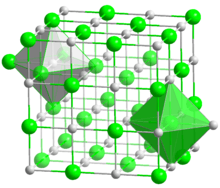Rubidium hydride
 | |
| Names | |
|---|---|
| IUPAC name
Rubidium hydride | |
| Other names
Rubidium(I) hydride | |
| Identifiers | |
| 13446-75-8 | |
| 3D model (Jmol) | Interactive image |
| PubChem | 171411 |
| |
| |
| Properties | |
| RbH | |
| Molar mass | 86.476 g/mol |
| Appearance | white cubic crystals |
| Density | 2.60 g/cm3 |
| Melting point | Decomposes at 170°C |
| reacts | |
| Structure | |
| cubic, cF8 | |
| Fm3m, No. 225 | |
| Thermochemistry | |
| Std enthalpy of formation (ΔfH |
-52.3 kJ/mol |
| Related compounds | |
| Other anions |
Rubidium oxide Rubidium chloride |
| Other cations |
Lithium hydride Sodium hydride Potassium hydride Caesium hydride |
| Except where otherwise noted, data are given for materials in their standard state (at 25 °C [77 °F], 100 kPa). | |
| | |
| Infobox references | |
Rubidium hydride is the hydride of rubidium. It has the formula RbH and is an alkali metal hydride. It is synthesized using rubidium metal to react with hydrogen gas. As a hydride of an alkali metal, it is reactive towards even weak oxidizing agents. A redox reaction will occur with chlorine or fluorine and a lot of heat will evolve. Rubidium hydride will react violently with water or air and careful storage is necessary.
References
This article is issued from Wikipedia - version of the 9/21/2016. The text is available under the Creative Commons Attribution/Share Alike but additional terms may apply for the media files.






